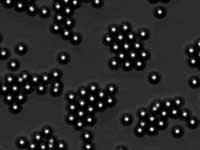Articles and reports from the Life Sciences and chemistry area deal with applied and basic research into modern biology, chemistry and human medicine.
Valuable information can be found on a range of life sciences fields including bacteriology, biochemistry, bionics, bioinformatics, biophysics, biotechnology, genetics, geobotany, human biology, marine biology, microbiology, molecular biology, cellular biology, zoology, bioinorganic chemistry, microchemistry and environmental chemistry.

OHSU, VAMC, Roche scientists use mouse genetics to discover Alox15 gene as potential human therapeutic target
Researchers at Oregon Health & Science University, Portland Veterans Affairs Medical Center and Roche have identified an enzyme affecting skeletal development in mice that may have relevance to human osteoporosis.
The study, titled “Regulation of Bone Mass in Mice by the Lipoxygenase Gene Alox 15,” is published in the Friday, Jan. 9 edition of Science, the journal of

The secret of flowering in our major food crops like wheat has been revealed with the discovery by CSIRO Plant Industry of a gene that triggers flowering in cereals.
“Important cereal crops like wheat and barley rely on the gene we found, WAP1, to initiate flowering,” says Dr Ben Trevaskis, CSIRO Plant Industry.
“Flowering is important because it determines when the plant will produce grain or fruit – the parts we usually eat.”
WAP1 turns ’on’ to activate flowering when

Microscopic glass beads wearing coats identical to the outer membrane of a cell provide a powerful assay for proteins that bind to cell membranes, such as protein drugs or drug candidates, according to chemists at the University of California, Berkeley, and Lawrence Berkeley National Laboratory (LBNL).
The membrane-coated beads, complete with receptors that dot the surfaces of real cells, also would make a sensitive detection system for viruses or protein toxins like those produced by choler

Acinetobacter baumannii is an opportunistic pathogen operating in hospitals creating serious infections such as pneumonia. It principally affects patients who have weakened health and this is why we call it opportunistic. Moreover, the mortality rate from these infections are usually high given, on the one hand, the weakness of the patient and, on the other, A. baumannii is resistant to many antibiotics. Furthermore, once a specific course of treatment is prescribed for A. Baumannii, the pathogen has

Because of their therapeutic potential, stem cells are today a major focus of at-tention in biomedical research. To realise this potential, however, it is essential to know the signal factors that can regulate the differentiation of a stem cell into the various cell types of an organism. An important factor in stem cell biology is the signal protein “Wnt”. In the case of quite a number of stem cell types, such as embryonal stem cells or stem cells of the central nervous system, “Wnt” re-sults in cell

Mayo Clinic genomics researchers are the first to demonstrate that mixing of genetic material can occur naturally, in a living body. The researchers have discovered conditions in which pig cells and human cells can fuse together in the body to yield hybrid cells that contain genetic material from both species and carry a swine virus similar to HIV (the virus that causes AIDS) that can infect normal human cells.
While the research does not answer the question of whether this infection can ca